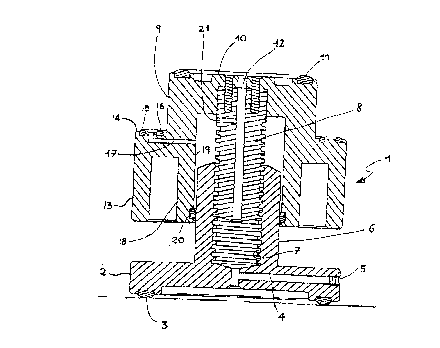Some of the information on this Web page has been provided by external sources. The Government of Canada is not responsible for the accuracy, reliability or currency of the information supplied by external sources. Users wishing to rely upon this information should consult directly with the source of the information. Content provided by external sources is not subject to official languages, privacy and accessibility requirements.
Any discrepancies in the text and image of the Claims and Abstract are due to differing posting times. Text of the Claims and Abstract are posted:
| (12) Patent Application: | (11) CA 2272207 |
|---|---|
| (54) English Title: | SYSTEM FOR THE PROFILE MACHINING WITH TEMPLATES OF SLABS OF MARBLE, STONE, GLASS AND THE LIKE |
| (54) French Title: | SYSTEME AVEC GABARITS POUR L'USINAGE DES PROFILS DE DALLES DE MARBRE, DE PIERRE, DE VERRE ET AUTRES |
| Status: | Deemed Abandoned and Beyond the Period of Reinstatement - Pending Response to Notice of Disregarded Communication |
| (51) International Patent Classification (IPC): |
|
|---|---|
| (72) Inventors : |
|
| (73) Owners : |
|
| (71) Applicants : |
|
| (74) Agent: | SMART & BIGGAR LP |
| (74) Associate agent: | |
| (45) Issued: | |
| (22) Filed Date: | 1999-05-19 |
| (41) Open to Public Inspection: | 1999-11-20 |
| Availability of licence: | N/A |
| Dedicated to the Public: | N/A |
| (25) Language of filing: | English |
| Patent Cooperation Treaty (PCT): | No |
|---|
| (30) Application Priority Data: | ||||||
|---|---|---|---|---|---|---|
|
A system for the profile machining of slabs (23) of marble, stone, glass and
the
like, using templates (31), comprises a plurality of mechanically adjustable
pneumatically
operating distance pieces or supporting blocks (1). Each distance piece or
supporting block is adjustable for height by means of a screw (8) and nut (6)
arrangement
and is provided with suction seals (11) on its end surface to support the
slab, (15,
16) on an annular step to fix the machining template, and (3) on its base to
fix the
assembly of slab and distance piece firmly to the workbench, as the slab is
being
machined. All the suction seals (3, 11, 15, 16) are connected to suction tubes
(24) that
terminate in a connecting nipple that is connected to a pneumatic vacuum
source.
Note: Claims are shown in the official language in which they were submitted.
Note: Descriptions are shown in the official language in which they were submitted.

2024-08-01:As part of the Next Generation Patents (NGP) transition, the Canadian Patents Database (CPD) now contains a more detailed Event History, which replicates the Event Log of our new back-office solution.
Please note that "Inactive:" events refers to events no longer in use in our new back-office solution.
For a clearer understanding of the status of the application/patent presented on this page, the site Disclaimer , as well as the definitions for Patent , Event History , Maintenance Fee and Payment History should be consulted.
| Description | Date |
|---|---|
| Inactive: IPC from MCD | 2006-03-12 |
| Inactive: IPC from MCD | 2006-03-12 |
| Application Not Reinstated by Deadline | 2003-05-20 |
| Time Limit for Reversal Expired | 2003-05-20 |
| Deemed Abandoned - Failure to Respond to Maintenance Fee Notice | 2002-05-21 |
| Application Published (Open to Public Inspection) | 1999-11-20 |
| Inactive: Cover page published | 1999-11-19 |
| Amendment Received - Voluntary Amendment | 1999-07-19 |
| Inactive: First IPC assigned | 1999-07-07 |
| Application Received - Regular National | 1999-06-17 |
| Filing Requirements Determined Compliant | 1999-06-17 |
| Inactive: Filing certificate - No RFE (English) | 1999-06-17 |
| Abandonment Date | Reason | Reinstatement Date |
|---|---|---|
| 2002-05-21 |
The last payment was received on 2001-03-23
Note : If the full payment has not been received on or before the date indicated, a further fee may be required which may be one of the following
Please refer to the CIPO Patent Fees web page to see all current fee amounts.
| Fee Type | Anniversary Year | Due Date | Paid Date |
|---|---|---|---|
| Application fee - small | 1999-05-19 | ||
| MF (application, 2nd anniv.) - small | 02 | 2001-05-21 | 2001-03-23 |
Note: Records showing the ownership history in alphabetical order.
| Current Owners on Record |
|---|
| QUINTILIO LUPI |
| Past Owners on Record |
|---|
| None |